Some daily events in the changing sky for September 18 – 26.
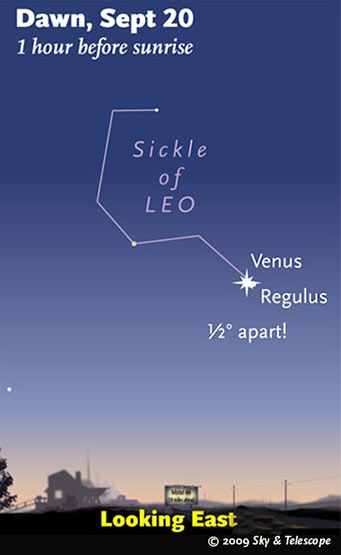
Bright Venus and much fainter Regulus pair up closely on the morning of Sunday the 20th. Bring binoculars.
Sky & Telescope diagram
Friday, Sept. 18
Saturday, Sept. 19
Sunday, Sept. 20
Monday, Sept. 21
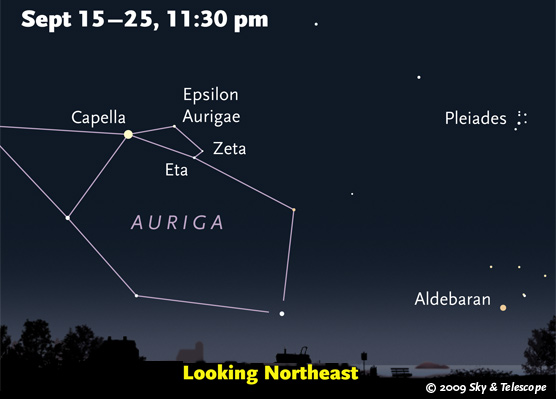
Stay up late, and already you can see bright Capella and the constellation Auriga climbing up in the northeast. Epsilon Aurigae, 3rd magnitude, has just begun to fade into its much-anticipated, two-year-long eclipse. Carefully compare it to Zeta and Eta Aurigae; see our article. And see "The Very Long Mystery of Epsilon Aurigae" in the May 2009 Sky & Telescope, page 58. (Of course you keep your back issues, right?)
Sky & Telescope diagram
Tuesday, Sept. 22
For a complete list of such mutual events among Jupiter's satellites that are visible from North America through the end of the year, see the October Sky & Telescope, page 56.
Wednesday, Sept. 23
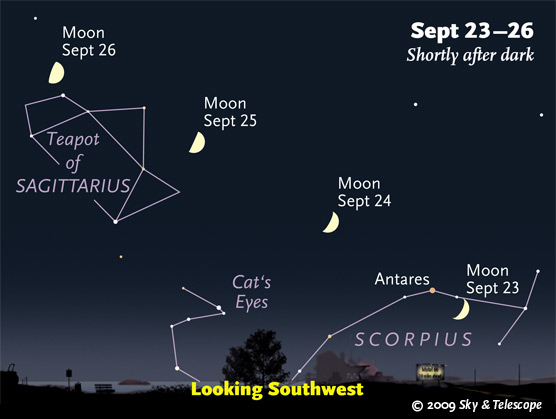
The waxing Moon passes through departing constellations of summer, as seen just after dusk. (These scenes are drawn for the middle of North America. European observers: move each Moon symbol a quarter of the way toward the one for the previous date. In the Far East, move it halfway. The Moon is shown three times life size, for clarity.)
Sky & Telescope diagram
Thursday, Sept. 24
Friday, Sept. 25
Saturday, Sept. 26
Want to become a better amateur astronomer? Learn your way around the constellations. They're the key to locating everything fainter and deeper to hunt with binoculars or a telescope. For an easy-to-use constellation guide covering the whole evening sky, use the big monthly map in each issue of Sky & Telescope, the essential magazine of astronomy. Or download our free Getting Started in Astronomy booklet (which only has bimonthly maps).
Sky Atlas 2000.0 (the color Deluxe Edition is shown here) plots 81,312 stars to magnitude 8.5. That includes most of the stars that you can see in a good finderscope, and typically one or two stars that will fall within a 50× telescope's field of view wherever you point. About 2,700 deep-sky objects to hunt are plotted among the stars.
Alan MacRobert
Once you get a telescope, to put it to good use you'll need a detailed, large-scale sky atlas (set of charts; the standards are Sky Atlas 2000.0 or the smaller Pocket Sky Atlas) and good deep-sky guidebooks (such as Sky Atlas 2000.0 Companion by Strong and Sinnott, the more detailed and descriptive Night Sky Observer's Guide by Kepple and Sanner, or the classic Burnham's Celestial Handbook). Read how to use them effectively.
Can a computerized telescope take their place? I don't think so — not for beginners, anyway, and especially not on mounts that are less than top-quality mechanically (they may not point quite where the computer tells them to). And as Terence Dickinson and Alan Dyer say in their Backyard Astronomer's Guide, "A full appreciation of the universe cannot come without developing the skills to find things in the sky and understanding how the sky works. This knowledge comes only by spending time under the stars with star maps in hand and a curious mind." Without these, "the sky never becomes a friendly place."
More beginners' tips: "How to Start Right in Astronomy".
This Week's Planet Roundup
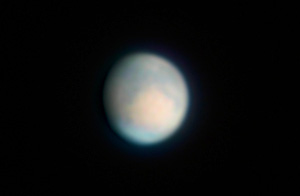
Mars is gradually growing bigger and brighter in the morning sky. The planet was still only 6.3 arcseconds in diameter when S&T's Sean Walker took this stacked-video image on the morning of September 21st, but recognizable details are coming into high-resolution imagers' views. South is up. On the right (the disk's celestial east or following side), the diagonal dark band of Sinus Sabaeus ends at Sinus Meridiani near the limb. At left, dark Syrtis Major is approaching the sunset terminator. Bright Hellas is near top.
Note the north polar clouds. In coming months, as Martian northern winter gives way to spring, the clouds should clear to reveal the bright white north polar cap. Walker used a 12.5-inch reflector and RGB color filters.
S&T: Sean Walker
Mercury is hidden in the glare of the Sun.
Venus (magnitude –3.9, in Leo) shines low in the east before and during dawn. Look for Regulus, much fainter, just ½° from Venus on the morning of September 20th, then about 1° farther to Venus's upper right for each day thereafter.
Mars (magnitude +0.8, in Gemini near Pollux and Castor) rises around midnight or 1 a.m. and is very high in the east before dawn. In a telescope it's still only 6 arcseconds wide: a tiny, fuzzy blob, though noticeably gibbous. Mars is on its way to an unremarkable opposition late next January, when it will be 14 arcseconds wide.
Jupiter (magnitude –2.7, in Capricornus) comes into view in the southeast as twilight fades — the first "star" to appear after sunset. It's higher in better telescopic view by 9 or 10 p.m. The 4th-magnitude star less than ½° from Jupiter is Iota Capricorni.
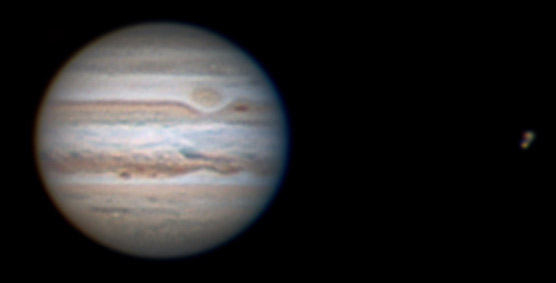
This year, Jupiter's Great Red Spot has been nicely bordered by the thick white line of the Red Spot Hollow, which indents the dark South Equatorial Belt. Note the very dark red barge following behind the pale Red Spot. The North Equatorial Belt is full of turbulence, including a big blue plume. Far to the right (celestial east), Ganymede and Europa are in conjunction. S&T's Sean Walker took this image at 1:15 UT September 3, 2009. South is up. Stacked-video images like this show much more detail than you're ever likely to see visually on Jupiter.
For all of the Red Spot's central-meridian crossing times, good worldwide, use our Red Spot calculator, or print out our list for the rest of 2009.
S&T: Sean Walker
Saturn is hidden behind the glare of the Sun.
Uranus (magnitude 5.7, just below the Circlet of Pisces) is well up in the southeast by 10 p.m.
Neptune (magnitude 7.8, in Capricornus) appears 6° east of Jupiter — and 16,000 times fainter. See our finder charts for Uranus and Neptune.
Pluto (14th magnitude, in northwestern Sagittarius) is still fairly well up in the south-southwest right after dark. See the finder chart in the June Sky & Telescope, page 53. Good luck.
All descriptions that relate to your horizon or zenith — including the words up, down, right, and left — are written for the world's mid-northern latitudes. Descriptions that also depend on longitude (mainly Moon positions) are for North America. Eastern Daylight Time (EDT) equals Universal Time (also known as UT, UTC, or GMT) minus 4 hours.
To be sure to get the current Sky at a Glance, bookmark this URL:
http://SkyandTelescope.com/observing/ataglance?1=1
If pictures fail to load, refresh the page. If they still fail to load, change the 1 at the end of the URL to any other character and try again.
 0
0
Comments
You must be logged in to post a comment.